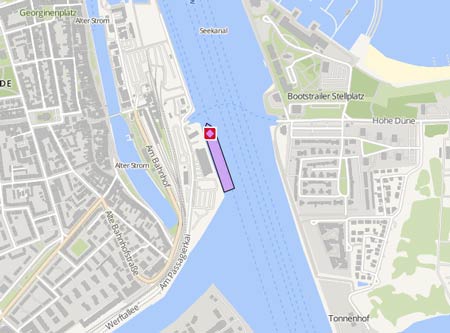4-WINDS
Kurs/Position
Die letzten Häfen
Die letzten Wegpunkte
Die neuesten Nachrichten
Tough start for wreck investigation
The investigations at the wreck of the 'Estonia' has commenced. The first pictures from the photo shoot have been published. On June 7 the investigation was started by immersing an ROV from the 'VOS Sweet'to start the photogrammetry. But it got stuck under the ship just minutes after launching, being sucked in by the propellers. The adversity led to a day's delay, and it was only in the morning of June 9 that the drone could be launched again, filming and photographing the bottom of the ferry at a depth of 68-70 meters. The specially built ROV was lowered into the water in a steel cage to a depth of 45 meters. There, the drone left the cage and moved forward on its own. But at 11 a.m. the tether cable, which acts as a kind of "umbilical cord" to the ROV, has come off. It was probably sucked into one of the propellers of the 'VOS Sweet' again. The damage was now being fixed. The planning has taken into account technical problems and days with bad weather. Therefore, the problematic start has not shaken the schedule. The Accident Investigation Board Norway and companies specializing in underwater drones will be at sea for 12-16 days to investigate both the wreck and the bottom on which it lies. After the examination, it takes a few more months before the material is analyzed and a result can be presented. The background to the new surveys are the holes that were found and presented in the documentary "Estonia - the find that changes everything" which was broadcast in 2020 Report with photos: https://www.hbl.fi/artikel/c95297e7-0d5e-4960-81ed-dd78e94088ad https://www.folkbladet.nu/2022-06-09/nya-problem-vid-estonia-kabel-gick-av
VOS Sweet started photogrammetric survey of the Estonia wreck
The Estonian Safety Investigation Bureau and the Swedish Accident Investigation Authority have started the examination of the wreck of the Estonian ferry 'Estonia' (IMO: 7921033) with a photogrammetric survey of the wreck on June 7 aboard the 'VOS Sweet'. The Swedish Accident Investigation Authority held a public procurement for finding the entity to perform the study and a contract for conducting the photogrammetric survey was signed with a Swedish company by the name Ocean Discover AB whose subcontractor is a Danish enterprise JD-Contractor A/S. As of June 8, the ship was working in pos. 59° 22.53' N 021° 40.50' E. It had sailed from Vaestervik on June 6. The ship was also used during the 3D laser scanning surveys of the wreck two weeks earlier. The photogrammetric survey will last for around two weeks. The purpose of the surveys is to photogrammetrically document the wreck of the 'Estonia' and use the data to create a 3D model of the wreck. After the survey to be conducted in June, the collected data will be processed and the results of the photogrammetric survey are planned to be announced in September. More information about the preliminary assessment and surveys of the wreck is available on the website https://www.estonia1994.ee/en
VOS Sweet started preparations for survey of Estonia wreck
The Estonian Safety Investigation Bureau on May 23, 2022, started 3D laser scanning of the wreck of the ferry 'Estonia' (IMO: 9773064) that sank in the Baltic Sea en route from Tallinn to Stockholm on Sep 28, 1994. The purpose of the 3D laser scanning is to make a point cloud of the wreck of the ferry and its immediate surroundings, with the help of which a 3D model of the wreck will be created later. In addition to surveying the wreck and surrounding sea bottom, high-tech equipment will be used to explore the interior of the car deck of the sunken ferry. The 'VOS Sweet' arrived at the site of the 'Estonia's sinking on Ma 23 in the morning. As the first thing, the equipment was to be tested and calibrated. During the surveying at sea, work will be done 24 hours a day. The first task is to conduct surveys of the vehicle deck in order to get as detailed an overview as possible of the condition of the vehicle deck and the objects there. The study of the vehicle deck is technically very complicated. The aim is to get the best possible idea of the situation of the vehicle deck, including deformations as well as openings, such as doors, ventilation openings, engine room hatches and so on, and to determine whether they are closed or open. As the next thing, the wreck and the seabed will be surveyed, which includes a precision scan of the wreck. Third, high-priority areas where external damage to the wreck has been identified in previous investigations -- the bow part, including the ramp, the ramp opening, locks and hinges; damage to the starboard side and to the stern and the port side at the level of the sixth deck -- will be further explored. Areas of high importance also include areas of the seabed where the focus will be primarily on the line of contact between the wreck and the seabed and its immediate surroundings. A fourth portion of laser scanning will be carried out additionally if, based on preliminary assessments carried out at sea, an area on or around the wreck proves to be of particular interest. In advance the Safety Investigation Bureau organized a public procurement, which was won by a consortium consisting of ESC Risk Management OU and Baltic Taucherei- und Bergungsbetrieb Rostock GmbH as the main contractors and Kraken Robotics will deliver the 3D laser scanner service. The survey team is an international one, made up of experts from Estonia, Sweden, Germany, and Poland. The 3D laser scanning will take 4-5 days, depending on weather conditions and underwater visibility.
News schreiben

